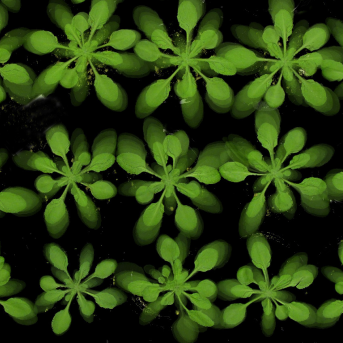Zoom on genetics complexity in plants
As a sessiles organisms, plants have to cope with environmental fluctuations and evolved a wide range of responses well illustrated by their great phenotypic plasticity and their ability to colonize very diverse habitats, through intraspecific genetic diversity.
Thanks to the Phenoscope, a robotised platform designed to cultivate plant and perform high throughput under strictly-controlled and reproducible conditions (see below), The team of Olivier Loudet managed to decifer the basal genetics of this vegetal diversity. On the Phenoscope, more than 700 cultivated Arabidopsis thaliana plants are moving continuously and consequently in an equivalent environment. They are weighed and watered and photographed very regularly. As a sessile organism, plants have to cope with environmental fluctuations and evolved a wide range of responses well illustrated by their great phenotypic plasticity and their ability to colonize very diverse habitats, through intraspecific genetic diversity.
Quantitative genetics approaches exploiting different crosses allowed to map the individual genetic loci (QTLs’: 'Quantitative Trait Loci') controlling different parameters linked to leaf growth with a precision never reach so far. Shoot growth and morphology have been analyzed in response to moderate water limitation. The team of Olivier Loudet studied Integrative traits such as those related to vegetative growth (highlighting either cumulative growth, growth rate) for 4 crosses between Arabidopsis variants (recombinant populations, RILs: Recombinant Inbred Lines). Subsequently, by focusing all of the mapping power on a small region representing 2.5% (3 Mégabases) of the genome of the model plant Arabidopsis in an unprecedentedly phenotyping effort, the unique cross analyzed revealed an underlying very complex so-called 'genetic architecture'. For example, several independent genes had remained hidden in this region beyond a major-effect gene controlling growth variation. Taking into account this hidden effects in cartography of QTLs is important to understand the variation of quantitative characters.
To study growth natural variability in a wild type species as Arabidopsis open doors to the discovery of new variants responding to stress and controlling adaptative characters of agronomic interest. A new order of magniture in predictive or digital biology could be announced: results of this study suggest that the genetics complexity being the base of phenotypic diversity is probably very underestimated.
Focus on the ‘Phenoscope’
Not far from 1 500 plants of Arabidopsis thaliana cultivated
on 2 of the 4 Phenoscope robots of the Plant Observatory
Deviced at the Institut Jean-Pierre Bourgin (IJPB, INRA Versailles-Grignon -Ile-de-France) and thanks to genetic ressources of the Arabidopsis thaliana Stock Center, the Phenoscope gather 4 unique robots in two culture chambers of the Plant Observatory (INRA patent) to observe plants at the vegetative stage (shoot).
It allows :
> to study more than 700 cultivated plants per robot
> to analyse large populations in controlled and reproducible conditions, being not feasible by hand and represent a bottle neck in modern biology
> or to characterize in detail a small number of different plants (genotypes) in a wide range of conditions (watering for example)
> to homogenise conditions by a continuous movement of plants (ex: typical cycle of 4 hours)
> 3 time less of repetitions necessary within each experiment
> dynamic shooting of growth with automatic extraction of characters by image analysis
The future XL Phenoscope is now being deviced: this prototype will receive plants including ones behond the flowering stage, up to the seed.
More information: https://phenoscope.versailles.inra.fr/
Back

Communiqué de presse INRA 22/04/19
Contact scientific Contact:
Olivier Loudet (01 30 83 32 17)
Institut Jean-Pierre Bourgin (INRAE, AgroParisTech)
Associated Division:
Plant biology and breeding
Associated Centre:
Ile-de-France-Versailles-Grignon
Contact(s) press:
INRAE Press room (01 42 75 91 86)
Référence:
The complex genetic architecture of shoot growth natural variation in Arabidopsis thaliana. Elodie Marchadier, Mathieu Hanemian, Sébastien Tisné, Liên Bach, Christos Bazakos, Elodie Gilbault, Parham Haddadi, Laetitia Virlouvet, Olivier Loudet. PLoS Genetics. 22th April 2019. https://doi.org/10.1371/journal.pgen.1007954